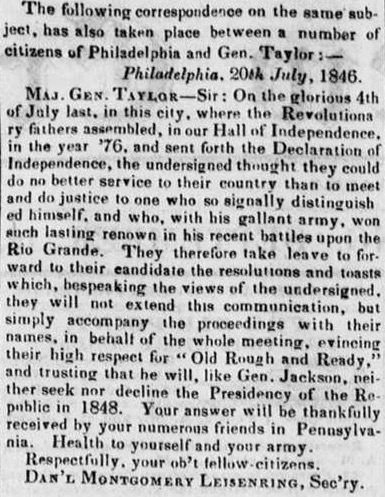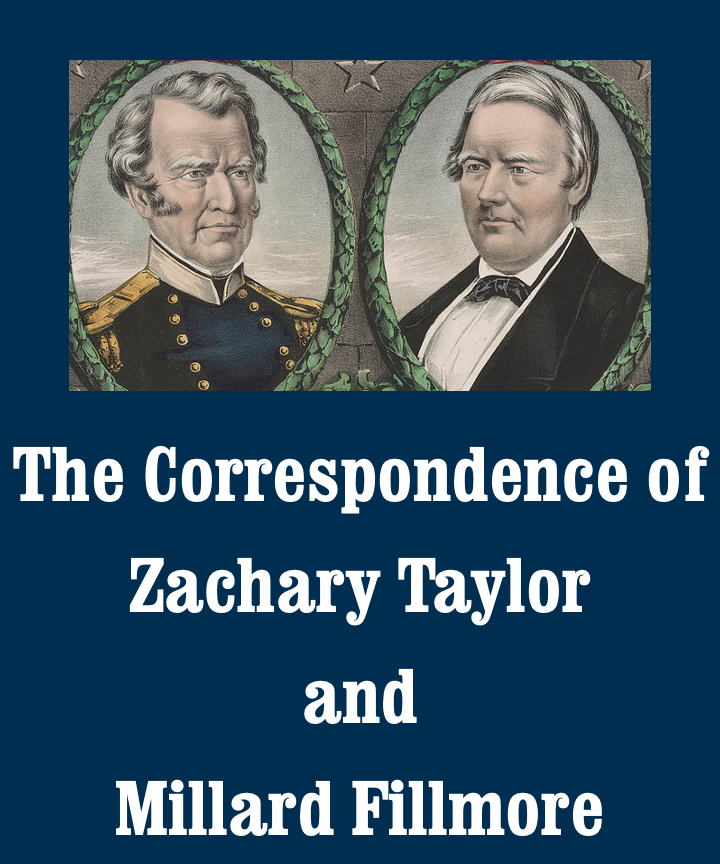This long weekend, Americans celebrate Independence Day. On July 4, 1776, the Continental Congress officially adopted Thomas Jefferson’s statement of the reasons for the United States to separate from the United Kingdom. Some early Americans, such as John Adams, expected the national holiday to be July 2, the date when the Congress had passed a brief resolution in favor of the separation itself. In the coming decades, however, the date associated with the Declaration of Independence took center stage.

Lithograph of Independence Day celebration by Otto Knitsch, in The Sons of Columbia. A national song [1850–80?]. Library of Congress.

Daniel Montgomery Leisenring to Taylor, July 20, 1846, in Portsmouth (VA) New Era, Sept. 12, 1846. Chronicling America/Library of Congress.
Fillmore himself was not above using the national holiday for partisan purposes. If you’ve seen our high school teaching guide on Texas annexation, you’ll remember his political use of it in 1844. Invited to two Whig meetings on July 4, he wrote a letter to one group comparing “[t]he whig spirit of ’76 [that] gave us Independence & freedom and the Whig spirit of 1844 [that] must maintain that independence and freedom.” The US Whig Party hadn’t existed in 1776 but drew its name from the history of British “Whigs” who opposed excessive royal authority. Fillmore, after tying his party to American independence—and by implication divorcing the Democrats from it—launched into a panegyric for the Whig presidential candidate Henry Clay. Independence Day, for antebellum politicians, was a time both to celebrate the nation and to promote political ends.
Unlike Fillmore, I am not traveling this July 4 weekend. But I did do so earlier this summer. June was a busy month for us documentary editors. Like the rest of the world, our profession has gradually been returning to pre-pandemic customs. As I mentioned in an earlier blog post, last fall we resumed traveling to libraries and archives to find new Taylor and Fillmore letters. In June, for the first time since 2019, I got to go to an in-person academic conference.
The American Political History Conference, hosted in West Lafayette, IN, by Purdue University, brought together historians who study politics from the seventeenth to the twenty-first centuries. You can watch several sessions, recorded by C-SPAN, on its website. I was part of a roundtable on “Editing Documents in US Political History.” Five of us discussed the process, value, evolution, and challenges of making primary sources accessible in print and digital formats. We drew on our experience editing the papers of the abolitionist Frederick Douglass; the first US Congress; and Presidents John Quincy Adams, Andrew Jackson, and (of course) Taylor and Fillmore. Later this month, you’ll be able to watch a recording of the session on our website.
The conversation was wide-ranging, but one broad theme emerged from all participants’ comments. By editing primary sources, we aim both to aid professional scholars as they write books and articles and to broaden access to original documents beyond professors and authors. Innovative online presentations of Adams’s diaries, use of Jackson’s writings in college classes, and this very blog are among our efforts to share the words of historical actors with all who want to better understand the nation’s past. To that end, I encourage you to let us know, though our contact form, what topics you’d like to see in future blog posts.
Soon after returning from Indiana, I attended—virtually, this time—the conference of the Association for Documentary Editing. That brought together, on Zoom, scores of editors to consider the best ways to share primary sources. It was great to hear of my colleagues’ work recovering and publishing the words of historical actors ranging from US presidents to Native Americans before the nation’s founding. We all look forward to next year’s in-person conference, which our project will cohost in Washington, DC, along with the Eleanor Roosevelt Papers Project at George Washington University. We have exciting presentations in the works that will appeal not just to editors but to professional and amateur historians alike. Stay tuned.
Between conferences, we’ve been hard at work putting together the first volume of Taylor’s and Fillmore’s correspondence. We’ve found thousands of letters that they wrote or received in 1844–48, the years of Texas annexation and the Mexican-American War, and Associate Editor Amy Larrabee Cotz and I have chosen a diverse subset of those to publish. We welcomed Mercedes Atwater, an MA student in public administration here at American University, as our newest editorial assistant. She’s already both transcribed letters and hunted for new ones in the National Archives’ microfilmed collections. Soon we will have a fully transcribed corpus of letters and will focus on proofreading those and writing the annotations that enable twenty-first-century readers to understand their contents.
Please forgive me for ending on a note of self-congratulation. Last week, the Siena College Research Institute released its latest ranking of the US presidents. Their team of scholars put Taylor at #36 and Fillmore at #38. Out of 45 chief executives, that’s not high praise. But FeedSpot also released its ranking of the “70 Best American History Blogs and Websites.” Quite to our surprise, this blog currently comes in at #33. Considering all the incredible resources in US history on the internet, from the Smithsonian’s National Museum of American History (#1) to Civil War Memory (#67) and well beyond, we are deeply honored.
